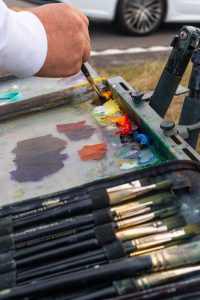Artists from Savannah and Atlanta will explore Georgia’s coastal culture and natural resources through art as part of Marine Extension and Georgia Sea Grant’s Artists, Writers and Scholars program, which launched in 2021.
The program supports projects designed to produce professional-quality art and literature that increases awareness of Georgia’s marine environments, improves understanding of Georgia’s coastal communities, and helps document history, culture, or heritage of Georgia’s coast.
“The Artist, Writers and Scholars program is inspiring new collaborations between marine researchers and the art community, and it’s allowing our organization to educate and inform audiences about the coast in exciting and creative ways,” says Mark Risse, director of Marine Extension and Georgia Sea Grant.
This year’s projects will document coastal change through paintings, capture climate impacts at a microscopic level through layered imagery, and explore the use of ceramics in oyster restoration.
The 2022 grant recipients include:
J. Kip Bradley, who has 20 years of community-based arts experience working with Savannah’s underserved populations. For the past 10 years, Bradley has worked locally and internationally, organizing sketching and painting groups and teaching workshops that encourage people to explore a sense of presentness through painting and drawing. As part of his project, Bradley has selected six coastal locations that he will paint four times over the span of a year, capturing seasonal and artistic changes in the marsh. He will share the process of painting each site on his blog, documenting the history and ecology at each site as well as observations of the people utilizing these publicly accessible locations. The final writings and 24 paintings will be made into hand-bound artist books, and the final paintings will be shared at an exhibit at the Kalmanson Gallery at East Georgia State College in Swainsboro in September 2023.
“The [project] will support efforts to immerse myself knee-deep in a muddy adventure to further my awareness and effort to find unity in the patterns of nature and painting through repetitive investigation, in order to share a story of appreciation for life at the marshes edge,” Bradley said.
Dana Montlack, who lives in Atlanta, has been interested in photography since the age of 15 when her grandfather taught her how to take and develop X-rays. Her work, which has been exhibited in museums and galleries around the globe, explores different topics through layered imagery of microorganisms, scientific data, charts or maps as a way of showcasing the natural world and the role humans play in it. She will work closely with Joel Kostka, professor and associate chair of research in the School of Biological Sciences at Georgia Tech, who studies microbial processes in the salt marsh, to visually explore the impacts of a changing climate on the Georgia coast.
She will photograph specimens and data collected at his research sites on the coast, while also incorporating maps and historical elements in her image layering process. The resulting photographs will be showcased at an exhibition in the summer of 2023.
“What I find exciting about collaboration across disciplines is the opportunity to learn about another’s perspective. I believe there is power in bringing two or more motivated individuals together from various fields. I hope my work can build a bridge to understanding, and, therefore, a willingness to make changes necessary for our environment to thrive,” Montlack said.
Savannah-based Casey Schachner is an assistant professor of Art in 3D Foundations at the Betty Foy Sanders Department of Art at Georgia Southern University. She re-configures commodified objects of the tourism industry to create sculptures that exhibit the relationships that exist between materials and place. Her work has been exhibited nationally and internationally, ranging from temporary site-specific installations to permanent public artworks. Schachner will be collaborating with students and faculty at Georgia Southern University to create art using the algal biomass that is produced from algal turf scrubbers. Algal turf scrubbers create algae mats that remove nutrients from the water and improve water quality. Schachner will use the algal biomass to create ceramic objects, including functional ware and sculptures as well as molds that will be used in oyster reef restoration. The pieces will be showcased in several artistic and educational venues to illustrate the value of Georgia’s coastal ecosystems and resources and engage the public on why these resources should be protected.

These bisque-fired test pieces using a clay/algae medium were made by Schachner’s student assistant, Nina Samuels.
“I believe it is critical as a visual artist exploring local environments to explore ways of visually communicating with the public about the places we inhabit. The ethical priorities of this project are to educate the public and provide them with tools to discuss, make plans, and take action for what the future holds in coastal communities,” Schachner said.




